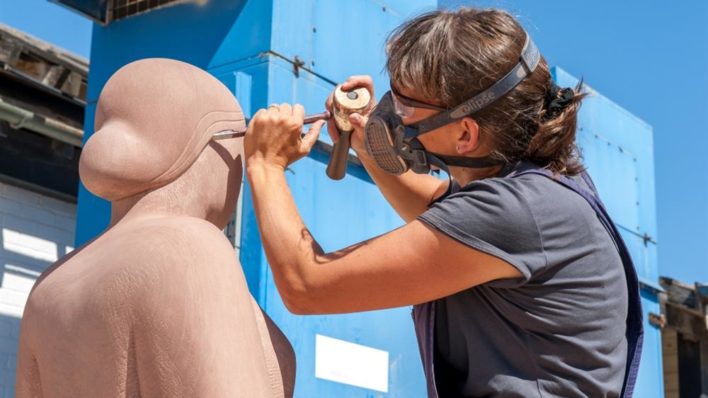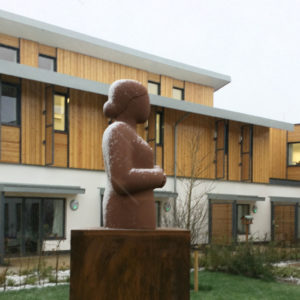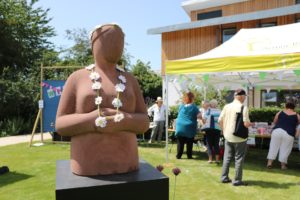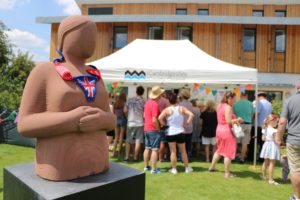Sculptor Lucy Churchill tells us more about ‘Figure of a Woman’
Share this article

“A sculpture by Lucy Churchill, Figure of a Woman, stands in the garden. A reassuring and comforting presence, she makes the space even more inviting and peaceful.”
Abi Cochran, who received bereavement support from the Arthur Rank Hospice during the summer of 2018.
If you have never crossed the threshold of a hospice, you may not appreciate just how many women play integral roles when it comes to end of life care and support.
In a work force of over 200 at Arthur Rank Hospice, 90% are women. Relatively recently, CEO of Cambridgeshire’s Arthur Rank Hospice, Dr Lynn Morgan MBE, came to the end of her nine-year tenure. Sharon Allen OBE took over the helm at the start of April 2019, soon after Lady Chadwyck-Healey became President of the Charity.
Watching over these changes is one rarely mentioned woman who remains to be celebrated. She sits in the landscaped gardens, quietly and steadfastly watching over the Hospice and everything that happens in it: Lucy Churchill’s ‘Figure of a Woman’.
Here, in our #HospiceArtStory, we take the opportunity to find out more about where the fondly regarded sculpture came from, as well as the inspiration and talent of the woman behind her.
How it began
Lucy Churchill was 25 when she got into stone carving. She had completed a degree in three-dimensional design and was working as an administrator at the Crafts Council when she witnessed a demonstration at a letter-cutting exhibition:
“I listened to the tap, tap, tap and just fell in love with it… At that point I had not carved at all – I just knew it was what I wanted to do.”
Her career in stone carving led her to making beautiful memorials and headstones. However, after almost 25 years, she started to wonder what it would be like to express her own feelings through her art:
“I feel those works don’t really belong to me: they are so much about the person I make it for. Suddenly I thought, wouldn’t it be a shame to have the skill to express whatever I want, but never actually be able to express myself in my own art? It was a very new thought, but it was there.”
In 2016 she decided to take a sabbatical for six months, put her commissions on hold and explore her art on a more personal level.
“The first month I just sat in my workshop, thinking ‘I don’t know. Maybe there’s nothing inside me after all’. After so many commissions to commemorate a specific person, it felt strange to make a piece of sculpture without an obvious purpose.”
One day, Lucy spoke to Helena Anderson, who was working on a photo project for the new Arthur Rank Hospice which was just being built at the time:
“I got a tingling feeling. I just felt that I would love to make a sculpture for the Hospice. I liked the idea of making something that would be a comforting distraction, and then suddenly I had something to work with, a sense of meaning and a starting point.”
She got in touch with Lynn Morgan, then CEO of the Hospice before it moved from the Mill Road site in Cambridge, explaining her situation and making it clear that there was no obligation to take the – as of yet, unimagined – sculpture. She explained that she would be willing to donate her time if a design was agreed upon, and donors could be found to cover the cost of the stone and installation.
Lucy explains how the partnership began:
“I wanted her to talk to me about the Hospice to give me a sense of it but allow me to follow my own ideas in creating the stone carving. I spent a lot of time watching the architect’s ‘fly-through’ video, so I could take into account the spaces and the colours that were being proposed for the Hospice’s new building.”
Lucy’s first thoughts about what the sculpture would be inspired by fitted seamlessly with the Hospice’s priorities:
“The patients who come to the Hospice were at the forefront of my mind, but I was also thinking about the members of the family that were going to have to be strong for their loved ones. I thought maybe people will look at the sculpture and identify with it, or maybe they will see the person who is caring for them in the Hospice – a member of staff or one of the many volunteers.
So, I was thinking about everybody who is there and how they have this supportive role. I wanted to convey the calm strength that so many people bring.”
She visited the Hospice for the first time, as it was being built in 2016, and remembers:
“It was a very emotional experience the first time I visited the Hospice. Afterwards, I couldn’t stop talking about it. I was struck by the very paleness of the building itself, the walls and the wood. That lightness made me want to choose a very warm-coloured stone. Definitely not a pale stone – I didn’t want it to look like a marble angel or anything even remotely like a memorial. I decided a red sandstone would look rather good with the Scandinavian colours of the Hospice.”
So began the search for the right piece of stone.
“I knew I wanted red sandstone so I got a whole patchwork of stone samples – about ten different types, some more orangey, some pinky, some red. I decided on the ones that looked suitably warm and interesting, but when I phoned up the quarries none had blocks that were big enough. The availability of stone changes all the time depending on which area is currently being quarried. I didn’t want to resort to sticking two blocks together to achieve the necessary height, so I either had to change my choice of stone or wait indefinitely until a sizeable block became available.”
“Then one day when I was at Fairhaven’s Stone Yard I saw that they had some large blocks of red sandstone there. Another stone yard had closed and they had bought their remnant stone, so nobody knew exactly which quarry it had come from. It was huge, two to three tons just lying at the back of their stone yard covered in moss.”
Though Lucy was happy to donate her sabbatical, she wasn’t in a position to buy such a large piece of stone as it would have cost over £1,000. However, she discussed the idea of creating a hospice sculpture with Jo Lowsby, Fairhaven’s Office Manager, who had lost her niece to cancer.
Jo offered to talk to Lady Fairhaven who generously agreed that the sandstone could be donated to the project. This was just the start of an essential relationship with Fairhaven Stone Yard, as Lucy goes onto explain:
“The sculpture weighs a third of a ton now, but it was a lot heavier than that at the start. Originally, I had planned to carve the sculpture in my workshop at home, but the block was too heavy for my lifting equipment. I realised that I would have to take the excess off, even just to move it!
In the end Fairhaven’s let me complete the whole project at their place. It was great to use their facilities- especially their lifting gear and dust extraction. And because I’ve worked for so long on my own in my studio, it was great fun to have the guys around in the stone yard. I think the masons enjoyed seeing the process of the block being angle-ground into the soft forms of my sculpted woman.”
Designing the Sculpture
Even before she began, Lucy had strong ideas of what she wanted to achieve with her work:
“I knew straight away that what I sculpted had to be appropriate to people of all sorts of faith and philosophy. That was the absolute starting point and I wanted whatever I made to be a comforting presence; something that just felt… reassuring.”
As preparation, before she picked up her tools, she went back to her roots, spending time sketching in museums like she had when she was a student. She visited the British Museum, the V&A and the Tate:
“I didn’t want the sculpture to look like anybody specific, in case it reminded people of someone they didn’t like! I looked at Barbara Hepworth’s sculptures and Henry Moore’s work and I noticed a lot of similarities to Sumerian figures in the way they simplified form – the important thing was the gesture, the overall impact, not whether the minor details were there, or were even correct.”
I turned back to these Sumerian statues that had always fascinated me in the Mesopotamian section of the British Museum. They were praying figures who would have been put into temples, to pray continuously on behalf of someone, while they got on with daily life. These figures are very solid and simple and have their hands arranged in an abstract way. You can’t physically hold your hands in the way they have it, but it looks…right. They look like they are gathering themselves and kind of waiting, but it looks very peaceful.
There is something about these sculptures that is almost Buddha like, calm but hopeful and there is something warm and gentle about them, the whole body is simplified into a gesture of composure.”
Having made many sketches which helped formulate her ideas more fully, Lucy moved onto the process of creating scale models in clay which she then cast into plaster.
“Initially I thought I would start with a man and a woman. I made some models of the woman very quickly and was happy with her. When I modelled the man, I wanted him to be a stylistic counterpart, whilst being obviously a person in his own right. I made the woman large because I wanted her to look warm, solid and reassuring. It is interesting, because a large female figure, she looks earthy and comforting, whereas a large man throws up different connotations. It was fascinating. I wanted to make the man look upright and slightly chipper, but once I’d finished modelling, I realised that the self-contained quality that I had given him, which older men often have, might be seen as being ‘on guard’ rather than calm and composed. The last thing I wanted was for people at the Hospice to feel that the figure might be confronting or judging them. So, I thought, ‘No, I’ll just go with the figure of a woman’.”
I discussed this dilemma with an art historian and she said that male figures generally embody a specific person, whereas women are traditionally used when wanting to express an emotional stance – such as faith, hope or welcome”.
Lucy began carving in February 2016 and the artistic challenges of her sabbatical project then became apparent:
“I really had to step back and change my way of working. Without a tight aesthetic brief from the client I had more stylistic freedom than I was used to. I come from a trade background where you complete your carving to an agreed plan and then move on to the next job. You work very hard and consistently from the moment you get there in the morning.
I had to shut down that part of me and allow myself to become much more contemplative….Just sit, look and think ‘How do I want this to go?’ I found this way of working excruciating at times, especially in the context of the busy masonry yard – just sitting on my hands and looking!”
Finding The Right Place
Before she had begun to carve, Lucy had envisioned that the sculpture would be in a hall way, greeting people. She knew it had to have a certain size, presence and weight in order for it to be an emotional “anchor” rather than just a “decorative bowl of potpourri, in the corner.
As the sculpture developed, a new idea formed:
“It was only when Lynn visited and I showed her the nature of the stone when it was wet, that she said: ‘It has got to go outside’. We realised then, that the sculpture should be in the Hospice’s gardens. It wasn’t something that we had anticipated.”
As she began shaping the stone with her 12-inch angle-grinder, the stone’s hidden depths began to reveal themselves.
“To start with, I chose the stone because it looked like a nice colour. But what you couldn’t tell when it was just a rough and overgrown block in the stoneyard, was that it has this lovely graining due to the composition of the stone. It is made up of many layers, each a different shade of pink, so when I carved it into rounded shapes it looked like an ordnance survey map!
Also, when it’s dry, the stone is a fleshy pink, like lips. But when it gets wet, it goes dark red and the graining becomes much more apparent. Especially as the different layers dry out at different rates, giving the surface of the sculpture an ever-changing appearance.”
In terms of style, Lucy purposely left a lot of tool marks on the stone’s surface:
“That was for several reasons. Leaving tool marks means that the stone catches the light in certain ways. It draws the eye and it’s an additional way of bringing emotion into the piece. According to how the light catches, it can change the appearance of the stone and the sculpture. Depending on where the light hits her face, it can highlight the eyebrows so it looks like she’s asking a question or if it catches her lips, like she’s about to say something.
Also some of the people who see it won’t be into art and won’t connect in that way. So I thought these people might be interested to see the tool marks so they can see how she’s been made. So – even if you don’t like it stylistically – there are little interesting distractions. I wanted her to have layers of interest. And I want people to feel the love and attention that’s gone into making the sculpture.
Just like the doors of the Hospice: they are made from really solid wood, but they’ve got bevelled edges. You open the door to go through it, and subconsciously, there’s a reassuring solidity and smoothness to it. With the tool marks it’s the same thing: they give you a subliminal sense of care and attention.”
‘Figure of a Woman’ – or Betsy as she has now come to be affectionately known as, by some at the Hospice – changes with weather and time, just as Lynn and Lucy predicted she would when the decision was made that she should be outside:
“When a sculpture is outside, you can see it weathering and aging. I think that is good because it gives you a perspective on things. It shows the passing of time. And the changing weather gives the sculpture daily interest. After it rains, the stone takes a while to dry and it dries in curious layers. If it snows, she gets to wear a little hat and shoulder-pads. People will go past her at different times of the day or different seasons and think ‘Oh, she looks different’. I hope she’s a welcome distraction, whatever the season…”

How did Lucy know that the sculpture was finished?
Lucy says she always has two answers to that question:
“One is that you suddenly feel there is a spirit in it. You suddenly see something, and you think: ‘There you are!’. I always give my carving a kiss then. The much more pragmatic answer is, you know when you are finished because you start introducing as many mistakes as improvements. And then you lay down your tools and back away!
I was trying to find a balance between making a modern-looking sculpture but also one with a timeless quality. I love the pieces in the British Museum, but I didn’t want the sculpture to look imported from a different culture. I wanted the hospice figure to look ‘relatable’, but not like a specific person… It was a delicate path to tread. By trying to take so many tastes into account, the figure could have looked bland rather than archetypal. So that was something that I was always scared of and attentive to.
When Lynn and Libby Howie, (the art critic who was acting as advisor on the Hospice’s collection of artworks) came to look at the sculpture, it still had only very suggestive features. They loved her as she was.
Until then I had been planning to sit back and look at her for a long time and consider whether to give her more defined features. But with approval given, I stopped there – there is always a danger that one can go too far in stone!
As she is, her features remain suggestive. People can project their own stories onto her.”
The sculpture is now as much a part of the garden as the trees and the birds, at home in the centre of a grass lawn, with the inpatient bedrooms to one side, Arthur’s Shed on another and the physiotherapy gym to the other. She’s at an angle on the axis of four trees facing the Sanctuary.
Lucy was determined that she should be within reach, as she goes on to explain:
“As a sculptor, the nicest thing for me is to go back and see that my work has been stroked. I want people to respond like that on a private and personal level. That is the greatest feeling. I want my carvings to be like a talisman of hope that people enjoy touching. That is the strange thing about sculpture. People imbue it with feelings. It is a piece of rock but once it’s shaped it can make you think certain things; it can make you feel a certain way. You can get comfort from just touching it. It’s that kind of communication, the conduit of feeling that really fascinates me. That is the magic of sculpture and I really hope people get some of that from my work. … I don’t want people saying: “What’s that for?”. I just want to prompt direct feeling. I hope that the figure is seen as someone who belongs to the Hospice and for people to look out of the window to see “what she’s up to today”.

I want people to feel comfortable with her and respond in whatever way they like… to feel they can lean against her, hug her and pat her. Sometimes my sculptures are given daisy chains in the summer or wear wreaths of holly at Christmas, and I love that. From my point of view, that’s the way sculpture should be, like a friend that’s just there. I want her to become part of the Hospice. I don’t know if that is too much to hope, but that would give me total fulfilment!”
Arthur Rank Hospice Charity provides outstanding specialist care and support to 4,100 patients living with an advanced serious illness or other life-limiting illness and those who need end of life care each year. Before the COVID-19 restrictions it held public open days once a quarter during which visitors were invited to cross the threshold of the Hospice to be given a guided tour of the facilities and gardens.

These open days were part of a wider approach designed to integrate the Hospice into the local community and debunk some of the negative myths which persist about Hospice care.
Visitors – both frequent and new – consistently remark upon how integral the gardens are to the brightness and ambience of the Hospice, creating a positive atmosphere which feels like home.
In the heart of the hospice’s landscaped gardens ‘Figure of a Woman’ has become – as Lucy Churchill had hoped – “an anchor” for staff, volunteers, visitors and patients alike, immediately recognisable and familiar. It is an iconic female figure, helping to make the Hospice “even more inviting and peaceful.”
You can read another #HospiceArtStory about the stunning photography around the Hospice, in this story about David Anthony Hall’s artwork.
Related articles
-

Over 550 Star Shine Walkers take to the streets of Cambridge
Over 500 supporters take part in Star Shine Night Walk Cambridge 2025
-

Star Shine Night Walk 2025 – Updated Information for on the day
Further updates regarding the hot weather and how to stay cool on the day...
-

Volunteers Week ‘Spotlight’
We have a team of over 600 very special and generous volunteers who support everything we do! We are shedding...
-

Hospice Volunteers recognised during National Volunteers Week 2025
Arthur Rank Hospice Charity says thank you to over 600 volunteers




